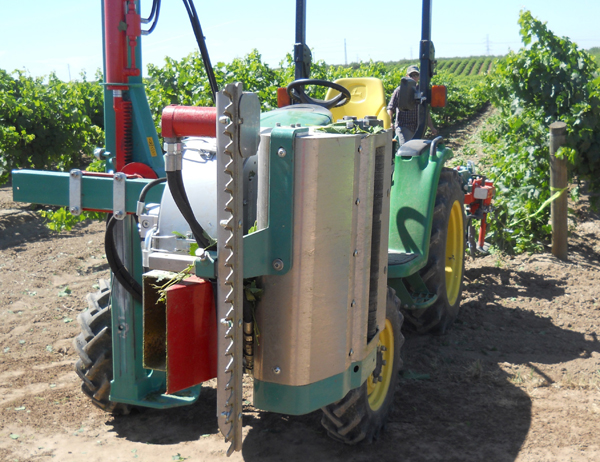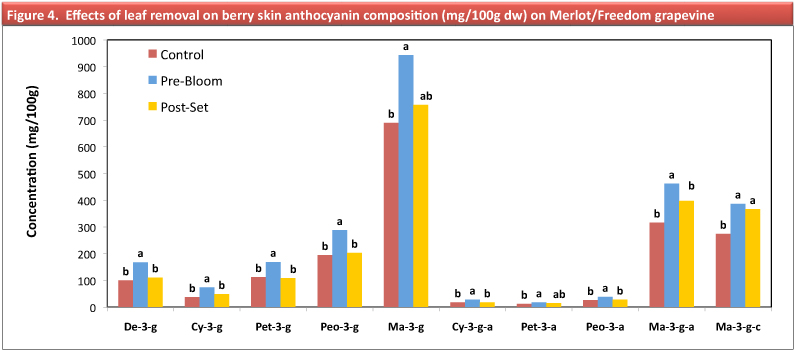California Agricultural Technology Institute
Early season leaf removal and reduced water use practices could boost San Joaquin Valley wine grape growers’ profits
A Fresno State viticulture research team has some good news for San Joaquin Valley wine grape growers facing critical water shortages due to the drought gripping California.
Results of a recent study have verified vineyard management practices that can reduce water use while at the same time increasing grape quality, reported Dr. Kaan Kurtural of the Viticulture and Enology Research Center (VERC). The practices involve mechanical leaf removal combined with reduced irrigation – vineyard management practices commonly known about but rarely practiced in the region.
 Vineyards in the San Joaquin Valley of California are large scale with tight profit
margins,” Kurtural stated. “Since yield is paramount, growers are typically unable
to apply effective canopy management and deficit irrigation practices, leading to
vines that produce large and dense canopies where excessive shading is an issue.”
Vineyards in the San Joaquin Valley of California are large scale with tight profit
margins,” Kurtural stated. “Since yield is paramount, growers are typically unable
to apply effective canopy management and deficit irrigation practices, leading to
vines that produce large and dense canopies where excessive shading is an issue.”
At left is a Clemens E-L 50 mechanical leaf remover (for sprawling type canopy) used in the study.
Excess shading can reduce grape quality by inhibiting phenolic accumulation in the grapes, he said. Phenolics represent a diverse class of chemical compounds found in minute concentrations in the berry, but they affect major attributes of wine such as color, aroma and flavor.
Leaf removal exposes the maturing berries to more sunlight, causing greater phenolic accumulation, but care and timing are critical so as to not expose the berries to too much of the sun’s radiation, which can reduce phenolic composition.
Leaf removal has been utilized in cool climate grape-growing regions to control yield while improving soluble solids and anthocyanins, which are another measure of grape quality, Kurtural said.
“However, there is a lack of research knowledge on the interactive effects of mechanical
leaf removal and phenology-based regulated deficit irrigation in the warm climate,”
he added. Thus, the objectives of this study were to determine the ideal phenology-based
timing of leaf removal along with an appropriate regulated deficit irrigation regime
that would improve berry quality without adversely affecting yield or berry phenolic
composition, and while reducing production costs. The study, conducted in 2013, featured two leaf removal treatments along with a control
of no leaf removal. For the non-control treatments, one consisted of pre-bloom leaf
removal with a Clemens E-L 50 mechanical leaf remover – in order to open a 50-centimeter
window in the fruiting zone. The second consisted of post-bloom leaf removal also
mechanically applied three times, ending at the onset of veraison.
The study, conducted in 2013, featured two leaf removal treatments along with a control
of no leaf removal. For the non-control treatments, one consisted of pre-bloom leaf
removal with a Clemens E-L 50 mechanical leaf remover – in order to open a 50-centimeter
window in the fruiting zone. The second consisted of post-bloom leaf removal also
mechanically applied three times, ending at the onset of veraison.
Photo at right shows leaf set removal on east side of canopy.
Two deficit irrigation treatments – consisting of 80 percent and 50 percent of standard evapotranspiration (ETo) requirements – with the dynamic crop coefficient (Kc) for grapevines also calculated in – were applied to each of the leaf removal treatments. All treatment combinations were replicated four times.
Results revealed that one application of pre-bloom leaf removal was successful in improving light infiltration into the fruiting zone, Kurtural said. Pre-bloom leaf removal increased skin mass dry weight compared to post-bloom leaf removal and was therefore able to attain maximum phenolic concentration in the berry skin, he added.
Perhaps more important were the results from the deficit irrigation treatments.
“Irrigation treatments had no negative effect on the majority of performance indices. Therefore water use can be reduced in order to decrease production cost,” Kurtural said.
The key to the deficit irrigation portion of the study was basing it on the crop coefficient (Kc) for grape vines rather than on the standard evapotranspiration (ETo) rates that are based on the water use of fescue grass, noted VERC graduate research fellow, Michael Cook, who assisted Kurtural in the study.
“Combining the cost of the treatments with the yield and quality results showed a reduction of operations labor cost for total anthocyanin produced per hectare,” Cook reported.

Based on units of anthocyanins produced per unit of water applied, which is one of the measures of grape quality, the cost/benefit indicator calculated for the deficit irrigation treatments performed 96 percent better than the control treatment in the study, and 435 percent better than conventional grower practice (not taking into account the dynamic crop coefficient for grapes), he stated.
The findings of this project are readily applicable in San Joaquin Valley Vineyards, Kurtural said. Growers can apply the leaf removal treatment one week prior to bloom to the morning side of the canopy, and implement the regulated 80-percent, 50-percent, and 80-percent ETo deficit irrigation treatment by obtaining the reference ETo from California Irrigation Management Information System.
Partial funding for this research came from the California State University Agricultural Research Institute (ARI). The American Vineyard Foundation and Bronco Wine Company provided additional funding. Technical assistance was provided by VERC research technician Geoffrey Dervishian, and Bronco Wine Company Area Manager Junior Robles.
For more information, contact Kurtural at kkurtural@csufresno.edu.